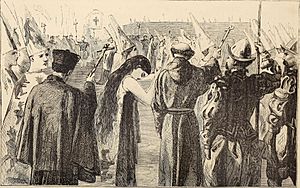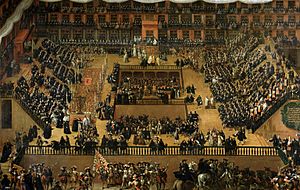Auto-da-fé facts for kids
An auto-da-fé (pronounced AW-toh-duh-FAY) was a special public ceremony that happened between the 1400s and 1800s. The name comes from Portuguese and means 'act of faith'. These ceremonies were organized by the Spanish, Portuguese, or Mexican Inquisition. They were a way to show public penance (saying sorry for wrongdoings) for people who were found guilty of heresy (beliefs against official church teachings) or Apostasy (leaving a religion). The most serious punishment was death by burning.
A Look Back at History
From the 700s to the 1400s, a large part of Spain was ruled by Muslims. Under their rules, Jews and Christians were considered "dhimmi." This meant they had to pay a special tax called the jizya. This tax was meant to remind them of their place and show their submission.
Sometimes, Jews could become important leaders. But there were also times of violence against them. For example, in the 1066 Granada massacre, many Jewish people in Granada were killed by a Muslim crowd.
How religious minorities were treated changed over time. For instance, the Almohads, who were Muslim rulers, made strict religious rules. They wanted everyone to be Muslim. This meant Jews and Christians had to either change their religion or leave.
Around the 11th century, Christians started to distrust Jews more. This led Christians to unite against both Muslims and Jews. Spain then became a mix of different powers and areas. Each had its own rules for Jews and Muslims. By the 1200s, most of modern Spain was under Christian rule. King Ferdinand III of Castile even said he was king of three religions. But this period of tolerance did not last long.
In the 1300s, some priests called for Jews to be removed from Spain. They blamed Jews for problems in society. This led Christians to destroy synagogues (Jewish places of worship) and force Jews to convert. Jews were made to attend sermons where Christian preachers explained what they saw as mistakes in Jewish beliefs.
New laws separated Jewish people and limited their jobs. The main goal was to make them convert to Christianity. More than 100,000 Jews did convert. Once they converted, these "New Christians" gained the same legal and social rights as other Christians. Many New Christians enjoyed their new status. After a few generations, these converted Jews saw themselves as regular Christians. Spain became almost entirely Christian.
But this religious sameness brought new worries. Christians who had always been Christian started to fear the "conversos" (converted Jews). They worried that these new Christians might not truly believe. Before, the differences between religious groups were clear. Laws showed Christian power in Spain. But once Jews converted, many Christians felt they could no longer tell who was truly loyal.
To calm these fears, "Purity of Blood" laws were created. These laws checked the family history of Christians to see if they had Jewish ancestors. This divided Christians in Spain based on their family background. It made those with Jewish blood seem "different," even after they converted. Some powerful Christians believed there was something in a person's very being that conversion could not change. These laws also brought back old false accusations against Jews, like the blood libel.
On November 1, 1478, King Ferdinand II of Aragon and Queen Isabella I of Castile got permission from Pope Sixtus IV. They could choose special judges called inquisitors across their lands. Their goal was to protect Catholicism as the only true Christian faith. This rule first applied to Isabella's kingdom, Castile. But in 1483, Ferdinand also brought it to his kingdom, Aragon.
Autos-da-fé became very popular across Spain. They were as exciting as bullfights and even royalty attended them. Ferdinand's actions sometimes met with resistance. For example, the inquisitor Pedro de Arbués was killed by converted Jews in 1485. But between 1487 and 1505, over 1,000 people accused of heresy were tried in Barcelona. Only 25 of them were found innocent.
After getting the Pope's permission, the kings started setting up permanent trials. They created offices to carry out investigations in most cities and towns. The first auto-da-fé in the Iberian Peninsula (Spain and Portugal) happened in Seville in 1481. Six people were found guilty and punished. Later, Franciscan missionaries brought the Inquisition to the New World (the Americas).
We don't know the exact number of people punished by the Inquisition. Some old records suggest very high numbers. For example, one former secretary of the Holy Office, Juan Antonio Llorente, said over 31,000 people were burned. Another historian, José Amador de los Ríos, gave even higher numbers. However, modern historians have looked closely at old records. They believe fewer than 10,000 people were actually punished during the entire Spanish Inquisition. Perhaps around 3,000 were executed.
The Portuguese Inquisition started in 1536 and officially ended in 1821. Its power became much weaker by the late 1700s. This happened under the government of the Marquês de Pombal.
Autos-da-fé also took place in other parts of the world. These included Goa (in India), New Spain (Mexico), the State of Brazil, and the Viceroyalty of Peru. Historians of the Conquistadors, like Bernal Díaz del Castillo, wrote about them. Even though records are not complete, one historian thinks about 50 people were punished by the Mexican Inquisition.
How the Process Worked
The auto-da-fé was a very important part of the Inquisition trials. It was the final step in the process. It included a Catholic Mass (church service), prayers, a public parade of those found guilty, and the reading of their sentences.
An Inquisition usually began with a public announcement. This announced a "grace period" of 40 days. During this time, anyone who was guilty, or knew someone who was guilty, was encouraged to confess. If someone was accused, they were usually thought to be guilty. Officials could use torture during the trial to get confessions. Inquisitors had to listen to and write down all statements. The trials were kept secret. The accused person did not know who their accusers were.
Officials announced the prisoner's sentence after the trial. This sentence was carried out in an auto-da-fé. The auto-da-fé was not a sudden event. It was carefully planned. Preparations started a month before. It only happened when the Inquisition leaders felt there were enough prisoners in a town or city. The ceremony took place in public squares or open areas. It lasted several hours, with church and government leaders attending.
A vigil (a period of staying awake and praying) would be held all night. This happened in or near the city's main square. It included prayers and ended with a Mass at sunrise. A breakfast feast was prepared for everyone who joined.
The public ceremony then began with a parade of prisoners. They wore special clothes and symbols. These symbols were called sanbenito. They were made of yellow cloth. They showed what specific acts of heresy the person was accused of. The prisoners' identities were kept secret until the very last moment. Also, the prisoners usually did not know what the result of their trial was or what their sentence would be.
The prisoners were taken to a place called the quemadero, or burning place. This was sometimes outside the city walls. There, the sentences were read aloud. Prisoners who were found innocent or whose sentence was put on hold would kneel in thanks. But those found guilty would face their punishment. Pictures of the auto-da-fé often show physical punishments. These included whipping, painful questioning, and burning at the stake.
The auto-da-fé was also a way for the public to show their own penance. By watching, they were part of a process of reconciliation. They were given a chance to think about their own sins and be forgiven by the Church.
Images for kids
-
1683 painting by Francisco Rizi showing the auto-da-fé in Plaza Mayor, Madrid, in 1680.
See also
 In Spanish: Auto de fe para niños
In Spanish: Auto de fe para niños





